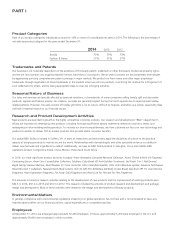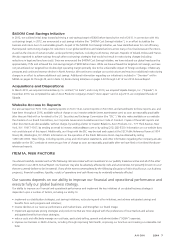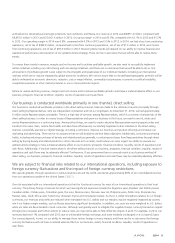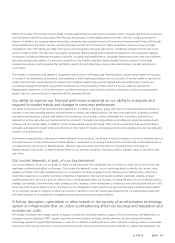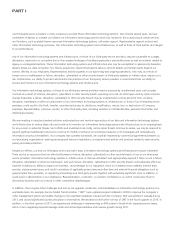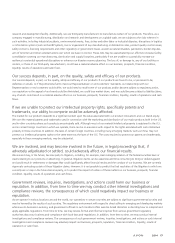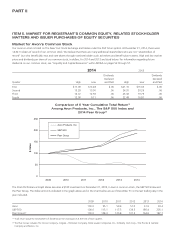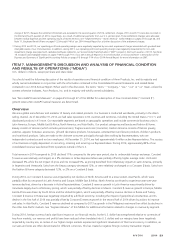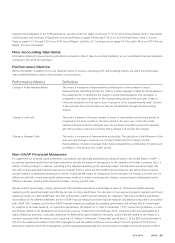Avon 2014 Annual Report Download - page 23
Download and view the complete annual report
Please find page 23 of the 2014 Avon annual report below. You can navigate through the pages in the report by either clicking on the pages listed below, or by using the keyword search tool below to find specific information within the annual report.Third-party suppliers provide, among other things, the raw materials used to manufacture our
Beauty products, and the loss of these suppliers or a disruption or interruption in the supply
chain may adversely affect our business.
We manufacture and package the majority of our Beauty products. Raw materials, consisting chiefly of essential oils, chemicals, containers
and packaging components, are purchased from various third-party suppliers for our Beauty products. All of our Fashion & Home products
are purchased from various suppliers. Additionally, we produce the brochures that are used by Representatives to sell Avon products. The
loss of multiple suppliers or a significant disruption or interruption in the supply chain could have a material adverse effect on the
manufacturing and packaging of our Beauty products, the purchasing of our Fashion & Home products or the production of our brochures.
This risk may be exacerbated by our globally-coordinated purchasing strategy, which leverages volumes. Regulatory action, such as
restrictions on importation, may also disrupt or interrupt our supply chain. Furthermore, increases in the costs of raw materials or other
commodities may adversely affect our profit margins if we are unable to pass along any higher costs in the form of price increases or
otherwise achieve cost efficiencies in manufacturing and distribution. In addition, if our suppliers fail to use ethical business practices and
comply with applicable laws and regulations, such as any child labor laws, our reputation could be harmed due to negative publicity.
Our indebtedness could adversely affect us by reducing our flexibility to respond to changing
business and economic conditions.
As of December 31, 2014, we had approximately $2.6 billion of indebtedness outstanding. We may also incur additional long-term
indebtedness and working capital lines of credit to meet future financing needs, subject to certain restrictions under our indebtedness,
including our revolving credit facility, which would increase our total indebtedness. We may be unable to generate sufficient cash flow from
operations and future borrowings and other financing may be unavailable in an amount sufficient to enable us to fund our future financial
obligations or our other liquidity needs. Our indebtedness could have material negative consequences on our business, prospects, financial
condition, liquidity, results of operations and cash flows, including the following:
• limitations on our ability to obtain additional debt or equity financing sufficient to fund growth, such as working capital and capital
expenditures requirements or to meet other cash requirements, in particular during periods in which credit markets are weak;
• a further downgrade in our credit ratings, as discussed above;
• a limitation on our flexibility to plan for, or react to, competitive challenges in our business and the beauty industry;
• the possibility that we are put at a competitive disadvantage relative to competitors that do not have as much debt as us, and competitors
that may be in a more favorable position to access additional capital resources and withstand economic downturns;
• limitations on our ability to execute business development activities to support our strategies or ability to execute restructuring as
necessary;
• limitations on our ability to invest in recruiting, retaining and servicing our Representatives; and
• compliance with certain covenants in our revolving credit facility as a result of a continued decline in our business results, which includes
the impact of any adverse foreign exchange movements, significant restructuring charges and significant legal or regulatory settlements;
difficulty obtaining necessary waivers from compliance with, or necessary amendments to, such covenants; and difficulty addressing the
impact any non-compliance with such covenants may have on our ability to secure financing with favorable terms.
If we incur additional indebtedness, the related risks that we now face (including those described above), could intensify.
Our ability to utilize our foreign tax and other U.S. credits to offset our future taxable income
may be limited under Sections 382 and 383 of the Internal Revenue Code.
As of December 31, 2014, we had approximately $674.8 million of foreign tax and other credits available to offset future income for
U.S. federal tax liability purposes. Our ability to utilize such credits to offset future income can be limited, however, if the Company
undergoes an “ownership change” within the meaning of Section 382 of the Internal Revenue Code of 1986, as amended (the “Code”). In
general, an ownership change will occur if there is a cumulative increase in ownership of our stock by 5% shareholders (as defined in the
Code) that exceeds 50 percentage points over a rolling three-year period. If the 50 percentage points are exceeded, Section 382 establishes
an annual limitation on the amount of deferred tax assets attributable to previously incurred credits that may be used to offset taxable
income in future years. A number of complex rules apply in calculating this limitation, and any such limitation would depend in part on the
market value of the Company at the time of the ownership change and prevailing interest rates at the time of calculation. As a result, the
magnitude of any potential limitation on the use of our deferred tax assets and the effect of such limitation on the Company if an ownership
change were to occur is difficult to assess. However, if all or a portion of our deferred tax assets were to become subject to this limitation,
our tax liability could increase significantly and our future results of operations and cash flows could be adversely impacted.
A V O N 2014 15



